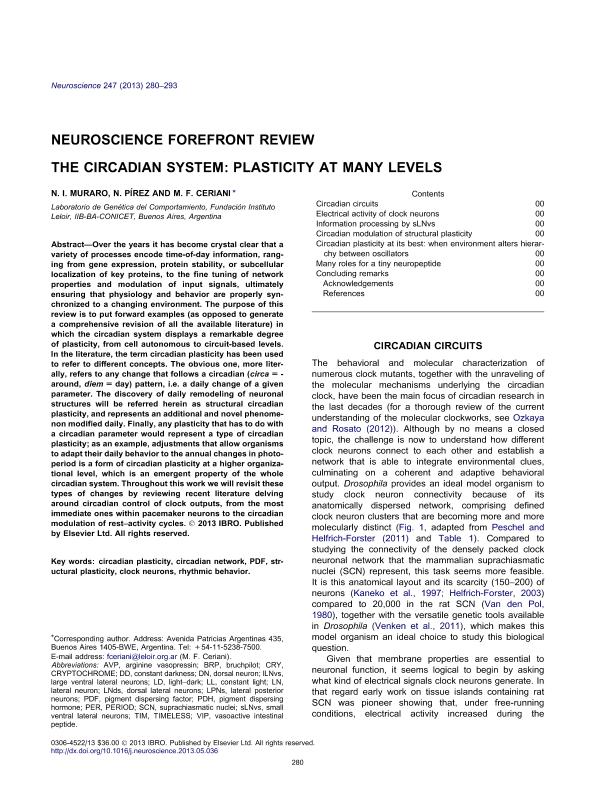Mostrar el registro sencillo del ítem
dc.contributor.author
Muraro, Nara Ines

dc.contributor.author
Pírez, Nicolas

dc.contributor.author
Ceriani, Maria Fernanda

dc.date.available
2017-06-16T19:03:56Z
dc.date.issued
2013-05
dc.identifier.citation
Muraro, Nara Ines; Pírez, Nicolas; Ceriani, Maria Fernanda; The circadian system: plasticity at many levels; Elsevier; Neuroscience; 247; 5-2013; 280-293
dc.identifier.issn
0306-4522
dc.identifier.uri
http://hdl.handle.net/11336/18332
dc.description.abstract
Over the years it has become crystal clear that a variety of processes encode time-of-day information, ranging from gene expression, protein stability, or subcellular localization of key proteins, to the fine tuning of network properties and modulation of input signals, ultimately ensuring that physiology and behavior are properly synchronized to a changing environment. The purpose of this review is to put forward examples (as opposed to generate a comprehensive revision of all the available literature) in which the circadian system displays a remarkable degree of plasticity, from cell autonomous to circuit-based levels. In the literature, the term circadian plasticity has been used to refer to different concepts. The obvious one, more literally, refers to any change that follows a circadian (circa=around, diem=day) pattern, i.e. a daily change of a given parameter. The discovery of daily remodeling of neuronal structures will be referred herein as structural circadian plasticity, and represents an additional and novel phenomenon modified daily. Finally, any plasticity that has to do with a circadian parameter would represent a type of circadian plasticity; as an example, adjustments that allow organisms to adapt their daily behavior to the annual changes in photoperiod is a form of circadian plasticity at a higher organizational level, which is an emergent property of the whole circadian system. Throughout this work we will revisit these types of changes by reviewing recent literature delving around circadian control of clock outputs, from the most immediate ones within pacemaker neurons to the circadian modulation of rest-activity cycles.
dc.format
application/pdf
dc.language.iso
eng
dc.publisher
Elsevier

dc.rights
info:eu-repo/semantics/openAccess
dc.rights.uri
https://creativecommons.org/licenses/by-nc-sa/2.5/ar/
dc.subject
Circadian Plasticity
dc.subject
Structural Plasticity
dc.subject
Circadian Network
dc.subject
Pdf
dc.subject.classification
Biología

dc.subject.classification
Ciencias Biológicas

dc.subject.classification
CIENCIAS NATURALES Y EXACTAS

dc.title
The circadian system: plasticity at many levels
dc.type
info:eu-repo/semantics/article
dc.type
info:ar-repo/semantics/artículo
dc.type
info:eu-repo/semantics/publishedVersion
dc.date.updated
2016-09-05T13:13:06Z
dc.identifier.eissn
1873-7544
dc.journal.volume
247
dc.journal.pagination
280-293
dc.journal.pais
Reino Unido

dc.journal.ciudad
Amsterdam
dc.description.fil
Fil: Muraro, Nara Ines. Consejo Nacional de Investigaciones Científicas y Técnicas. Oficina de Coordinación Administrativa Parque Centenario. Instituto de Investigaciones Bioquímicas de Buenos Aires. Fundación Instituto Leloir. Instituto de Investigaciones Bioquímicas de Buenos Aires; Argentina
dc.description.fil
Fil: Pírez, Nicolas. Consejo Nacional de Investigaciones Científicas y Técnicas. Oficina de Coordinación Administrativa Parque Centenario. Instituto de Investigaciones Bioquímicas de Buenos Aires. Fundación Instituto Leloir. Instituto de Investigaciones Bioquímicas de Buenos Aires; Argentina
dc.description.fil
Fil: Ceriani, Maria Fernanda. Consejo Nacional de Investigaciones Científicas y Técnicas. Oficina de Coordinación Administrativa Parque Centenario. Instituto de Investigaciones Bioquímicas de Buenos Aires. Fundación Instituto Leloir. Instituto de Investigaciones Bioquímicas de Buenos Aires; Argentina
dc.journal.title
Neuroscience

dc.relation.alternativeid
info:eu-repo/semantics/altIdentifier/url/http://www.sciencedirect.com/science/article/pii/S0306452213004648
dc.relation.alternativeid
info:eu-repo/semantics/altIdentifier/doi/http://dx.doi.org/10.1016/j.neuroscience.2013.05.036
Archivos asociados
